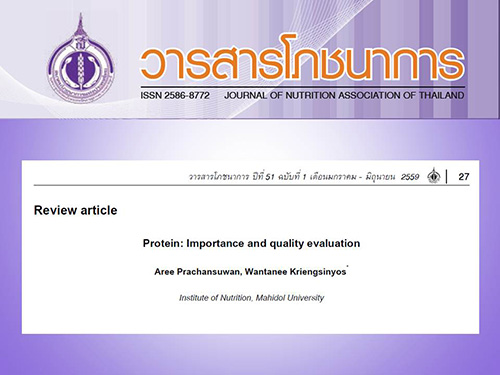Protein: Importance and quality evaluation
Keywords:
Protein quality and digestibility, Amino acid score, PDCAASAbstract
Protein is an essential nutrient for whole body particularly growth and development. Protein requirement for each people is determined by gender, age and health status. Dietary protein can be derived from both plant and animal sources which may have differences in protein quality. High quality protein is very important for support health in early and later life. The protein quality of food depends on the amount of indispensable amino acids and also its digestibility. Some foods are high in amino acids, but their digestibility are limited by the anti-nutritional factors. Hence, it is necessary to study the protein quality for preparing and coping with health, nutritional security and climate change problems. Furthermore, it can be used for creating and developing new recipes to improve food quality.
References
2. กองโภชนาการ กรมอนามัย กระทรวงสาธารณสุข. รายงานการสำรวจภาวะอาหารและโภชนาการของประเทศไทย ครั้งที่ 5 พ.ศ. 2546. กรุงเทพฯ: กระทรวงสาธารณสุข; 2549.
3. สำนักงานสำรวจสุขภาพของประชาชนไทย สถาบันวิจัยระบบสาธารณสุข. รายงานการสำรวจการบริโภคอาหารของประชาชนไทย การสำรวจสุขภาพประชาชนไทยโดยการตรวจร่างกายครั้งที่ 4 พ.ศ. 2551-2552. นนทบุรี: สถาบันวิจัยระบบสาธารณสุข; 2554.
4. Kosulwat V. The nutrition and health transition in Thailand. Public Health Nutr. 2002;5(1A):183-9.
5. คณะกรรมการจัดทำข้อกำหนดสารอาหารที่ควรได้รับประจำวันสำหรับคนไทย. ปริมาณสารอาหารอ้างอิงที่ควรได้รับประจำวัน สำหรับคนไทย พ.ศ. 2546. กรุงเทพฯ: กระทรวงสาธารณสุข; 2546.
6. FAO, WHO, UNU. Protein and amino acid requirements in human nutrition: Report of a joint FAO/WHO/UNU expert consultation (WHO Technical Report Series 935). Geneva: WHO; 2007.
7. กลุ่มงานวิเคราะห์อาหารและโภชนาการ กองโภชนาการ กรมอนามัย กระทรวงสาธารณสุข. ตารางแสดงชนิดและปริมาณกรดอะมิโนในอาหารไทย. กรุงเทพฯ: กระทรวงสาธารณสุข; 2544.
8. United States Department of Agriculture Agricultural Research Service. National Nutrient Database for Standard Reference Release 28. 2015 [cited 2015 December 21]. Available from: https://ndb.nal.usda.gov/ndb/nutrients/index.
9. Sarwar GC, Wu XC, Cockell KA. Impact of antinutritional factors in food proteins on the digestibility of protein and the bioavailability of amino acids and on protein quality. Br J Nutr. 2012;108(Suppl 2):S315-32.
10. Boye J, Wijesinha-Bettoni R, Burlingame B. Protein quality evaluation twenty years after the introduction of the protein digestibility corrected amino acid score method. Br J Nutr. 2012;108(Suppl 2):S183-211.
11. United Nations, Department of Economic and Social Affairs, Population Division. World Population Prospects: The 2015 Revision, Key Findings and Advance Tables. New York: United Nations; 2015.
12. Godfray HC, Crute IR, Haddad L, Lawrence D, Muir JF, Nisbett N, et al. The future of the global food system. Phil Trans R Soc B. 2010;365(1554):2769-77.
13. Victora CG, Adair L, Fall C, Hallal PC, Martorell R, Richter L, et al. Maternal and child undernutrition: consequences for adult health and human capital. Lancet. 2008;371:340-57.
14. สำนักงานสถิติแห่งชาติ และองค์การยูนิเซฟประเทศไทย. รายงานผลทั่วราชอาณาจักร การสำรวจสถานการณ์เด็กในประเทศไทย ธันวาคม พ.ศ. 2548 – กุมภาพันธ์ พ.ศ. 2549. กรุงเทพฯ: กระทรวงเทคโนโลยีสารสนเทศและการสื่อสาร; 2549.
15. สำนักงานสถิติแห่งชาติ, กระทรวงสาธารณสุข และองค์การยูนิเซฟประเทศไทย. รายงานการสำรวจสถานการณ์เด็กและสตรีในประเทศไทย พ.ศ. 2555. กรุงเทพฯ: กระทรวงเทคโนโลยีสารสนเทศและการสื่อสาร; 2555.
16. World Health Organization. Nutrition Landscape Information System (NLIS) Country Profile Indicators Interpretation Guide. Geneva: WHO; 2010.
17. Hoppe C, Molgaard C, Thomsen BL, Juul A, Michaelsen KF. Protein intake at 9 mo of age is associated with body size but not with body fat in 10-y-old Danish children. AM J Clin Nutr. 2004;79(3):494-501.
18. Stephenson K, Amthor R, Mallowa S, Nungo R, Maziya-Dixon B, Gichuk S, et al. Consuming cassava as a staple food places children 2-5 years old at risk for inadequate protein intake, an observational study in Kenya and Nigeria. Nutr J. 2010;9:9.
19. Esfarjani F, Roustaee R, Mohammadi-Nasrabadi F, Esmaillzadeh A. Major dietary patterns in relation to stunting among children in Tehran, Iran. J Health Popul Nutr. 2013;31(2):202-10.
20. Jamison DT, Leslie J, Musgrove P. Malnutrition and dietary protein: evidence from China and from international comparisons. Food Nutr Bull. 2003;24(2):145-54.

Downloads
Published
How to Cite
Issue
Section
License
Upon acceptance of an article, copyright is belonging to the Nutrition Association of Thailand.


